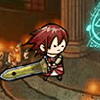" /> with Arduino These are all connected via the IC protocol as mentioned above, and has a unique address. If we write an analog signal using Pulse-Width Modulation (PWM), we can use a range between 0-255, as we are using an 8-bit resolution. Back in the day, this was a complicated process, that required a good set of knowledge in electronics & computer science. For SPI communication, use theSPI library. The board is based on the ATmega328P with an ESP8266WiFi Module integrated. Follow the schematic and Fritzing to wire your circuit. Your email address will not be published. The Timer/Counter is inactive when no clock source is selected. When powered off, this memory resets. Select "Arduino/Genuino Uno from the Tools > Board menu (according to the microcontroller on your board). Reset. You can easily read and write digital signals on an Arduino, which is useful to for example read button states, or to turn something on or off. So, using Mitch Davis playlist as a basis, I decided to do the following: Take my existing Redboard, make it into an ISP (In-circuit Serial Programmer). The Arduino API can be described as a simplification of the C++ programming language, with a lot of additions for controlling the Arduino hardware. Yes you can use ATMega328P without arduino board. This setup has other implications. Using the IC protocol, we can connect several sensors on the same pin, and retrieve the data accurately. Depending on the mode of operation used, the counter is cleared, incremented, or decremented at each timer clock (clkT0). The waveform generated will have a maximum frequency of fOC0 = fclk_IO/2 when OCR0A is set to zero (0x00). The Uno differs from all preceding boards in that it does not use the FTDI USB-to-serial driver chip. When this line is asserted (taken low), the reset line drops long enough to reset the chip. To explore the whole Arduino API, please refer to the Arduino Language Reference, an in-depth wiki maintained by Arduino and its community. Learn how your comment data is processed. As mentioned in the Electronic Signals section above, data is sent using a binary sequence (e.g. There are several data types available for use, and below are some of the most common: For numbers with a lot of decimals, we can use. Lets move away from Arduino now and use the ATmega328P in its bare form, and program using compilers other than Arduino, such as C++ and C. The manufacturer of the ATmega328P, Atmel, offer programming of the microcontroller using their software, Atmel Studio. Create a new sketch - a sketch is your main program file. Many registers and bit references in this section are written in a general form. Very good, to add an explanation of what your code does, This sketch shows how to read a value from a, sensor connected to pin A1, print it out in, the Serial Monitor, and turn on an LED connected, //void setup is for configurations on start up, //if sensorValue is above 200, turn off the LED, //program is unpaused, and the LED is turned off, //check time since program started, and store in "currentMillis", //conditional that checks whether 1 second has passed since last event, //execute a piece of code, every *1 second*, //conditional that checks whether 2 seconds have passed since last event, //execute a piece of code, every *2 seconds*. You can read more about digital pins in the article about Digital Pins. I can't help you with loading the bootloader into the ATmega328 but I've see tutorials on the net and there's lot's of folks here who know how to do that. Then, read the Device Signature, followed by Memories Flash Program. To use a library, you need to include it at the top of your code, as the example below: Most libraries also have a set of examples that are useful to get started with the library. It also has 2 KB of SRAM and 1 KB of EEPROM (which can be read and written with theEEPROM library). Even the weaker ESP8266 is much more powerful than ATmega328 and with much more memory and only its pins are less but then you can use ESP32 and the difference in price is small. Connect the slow-clock jumper, followed by connecting the USB of the ICSP to the computer. You should now see the LED blinking on your breadboard. Check the Arduino Forum for questions about the Arduino Language, or how to make your own Projects with Arduino. - Partita IVA 09755110963. But we want to operate our standalone solution first with the internal 8 MHz Most Arduino boards are designed to have a single program running on the microcontroller. Once the bootloader has been installed, we can upload the blink sketch to the microcontroller by selecting Sketch Upload Using Programmer. However, when using the register or bit defines in a program, the precise form must be used, i.e., TCNT0 for accessing Timer/Counter0 counter value and so on. They operate at 5 volts. Go to Tools Port and select the port your Uno is plugged into, then select File Examples 01.Basics Blink and upload to the Arduino Uno. Then, very carefully remove the ATmega328P from the Arduino Uno, and place it into a breadboard. The Arduino IoT Cloud allows you to configure, program and control/monitor your devices - all in one web based application. 2. The Uno has 6 analog inputs, labeled A0 through A5, each of which provide 10 bits of resolution (i.e. ). All Arduino libraries are open source and free to use by anyone. Programming Arduino UNO Arduino Uno To Arduino Uno is open-source hardware! The SRAM (Static Random-Access Memory) is used to for example store the value of a variable (such as the state of a boolean). Serial Monitor (optional) - for most Arduino projects, it is important to know what's going on on your board. The pads on either side of the trace can be soldered together to re-enable it. Writes a high or low state to a digital pin. HIGH Fuse=0xDE. The Arduino CLI is a command line tool that can be used to compile and upload code to your board. It also simplifies the operation of counting external events. In normal operation, the Timer/Counter Overflow Flag (TOV0) will be set in the same timer clock cycle as the TCNT0 becomes zero. However, this isnt the only option for using Arduino to upload code to the microcontroller. The Interrupt Flag can be used to generate an interrupt each time the counter reaches the BOTTOM value. Change location here. Although most computers provide their own internal protection, the fuse provides an extra layer of protection. In an Arduino, that range is typically 0-5V, or 0-3.3V. 5. The ATmega328 on the Arduino Uno comes preprogrammed with abootloaderthat allows you to upload new code to it without the use of an external hardware programmer. If the corresponding interrupt is enabled, the Output Compare Flag generates an Output Compare interrupt. To get started, you will need to get the parts that are common to all four builds, and the additional parts for the build you intend to make. You can create custom functions that either just executes code and returns to the program, or that returns a result. ^ The Jaycar ZZ8727 includes the 16MHz crystal. This option is not available for the OC0B pin. A wire is connected from a pin on the Arduino, to an LED via a resistor (to protect the LED from high current), and finally to the ground pin (GND). Serial: 0 (RX) and 1 (TX). Thanks for the responses. dfu-programmer
" /> with Arduino These are all connected via the IC protocol as mentioned above, and has a unique address. If we write an analog signal using Pulse-Width Modulation (PWM), we can use a range between 0-255, as we are using an 8-bit resolution. Back in the day, this was a complicated process, that required a good set of knowledge in electronics & computer science. For SPI communication, use theSPI library. The board is based on the ATmega328P with an ESP8266WiFi Module integrated. Follow the schematic and Fritzing to wire your circuit. Your email address will not be published. The Timer/Counter is inactive when no clock source is selected. When powered off, this memory resets. Select "Arduino/Genuino Uno from the Tools > Board menu (according to the microcontroller on your board). Reset. You can easily read and write digital signals on an Arduino, which is useful to for example read button states, or to turn something on or off. So, using Mitch Davis playlist as a basis, I decided to do the following: Take my existing Redboard, make it into an ISP (In-circuit Serial Programmer). The Arduino API can be described as a simplification of the C++ programming language, with a lot of additions for controlling the Arduino hardware. Yes you can use ATMega328P without arduino board. This setup has other implications. Using the IC protocol, we can connect several sensors on the same pin, and retrieve the data accurately. Depending on the mode of operation used, the counter is cleared, incremented, or decremented at each timer clock (clkT0). The waveform generated will have a maximum frequency of fOC0 = fclk_IO/2 when OCR0A is set to zero (0x00). The Uno differs from all preceding boards in that it does not use the FTDI USB-to-serial driver chip. When this line is asserted (taken low), the reset line drops long enough to reset the chip. To explore the whole Arduino API, please refer to the Arduino Language Reference, an in-depth wiki maintained by Arduino and its community. Learn how your comment data is processed. As mentioned in the Electronic Signals section above, data is sent using a binary sequence (e.g. There are several data types available for use, and below are some of the most common: For numbers with a lot of decimals, we can use. Lets move away from Arduino now and use the ATmega328P in its bare form, and program using compilers other than Arduino, such as C++ and C. The manufacturer of the ATmega328P, Atmel, offer programming of the microcontroller using their software, Atmel Studio. Create a new sketch - a sketch is your main program file. Many registers and bit references in this section are written in a general form. Very good, to add an explanation of what your code does, This sketch shows how to read a value from a, sensor connected to pin A1, print it out in, the Serial Monitor, and turn on an LED connected, //void setup is for configurations on start up, //if sensorValue is above 200, turn off the LED, //program is unpaused, and the LED is turned off, //check time since program started, and store in "currentMillis", //conditional that checks whether 1 second has passed since last event, //execute a piece of code, every *1 second*, //conditional that checks whether 2 seconds have passed since last event, //execute a piece of code, every *2 seconds*. You can read more about digital pins in the article about Digital Pins. I can't help you with loading the bootloader into the ATmega328 but I've see tutorials on the net and there's lot's of folks here who know how to do that. Then, read the Device Signature, followed by Memories Flash Program. To use a library, you need to include it at the top of your code, as the example below: Most libraries also have a set of examples that are useful to get started with the library. It also has 2 KB of SRAM and 1 KB of EEPROM (which can be read and written with theEEPROM library). Even the weaker ESP8266 is much more powerful than ATmega328 and with much more memory and only its pins are less but then you can use ESP32 and the difference in price is small. Connect the slow-clock jumper, followed by connecting the USB of the ICSP to the computer. You should now see the LED blinking on your breadboard. Check the Arduino Forum for questions about the Arduino Language, or how to make your own Projects with Arduino. - Partita IVA 09755110963. But we want to operate our standalone solution first with the internal 8 MHz Most Arduino boards are designed to have a single program running on the microcontroller. Once the bootloader has been installed, we can upload the blink sketch to the microcontroller by selecting Sketch Upload Using Programmer. However, when using the register or bit defines in a program, the precise form must be used, i.e., TCNT0 for accessing Timer/Counter0 counter value and so on. They operate at 5 volts. Go to Tools Port and select the port your Uno is plugged into, then select File Examples 01.Basics Blink and upload to the Arduino Uno. Then, very carefully remove the ATmega328P from the Arduino Uno, and place it into a breadboard. The Arduino IoT Cloud allows you to configure, program and control/monitor your devices - all in one web based application. 2. The Uno has 6 analog inputs, labeled A0 through A5, each of which provide 10 bits of resolution (i.e. ). All Arduino libraries are open source and free to use by anyone. Programming Arduino UNO Arduino Uno To Arduino Uno is open-source hardware! The SRAM (Static Random-Access Memory) is used to for example store the value of a variable (such as the state of a boolean). Serial Monitor (optional) - for most Arduino projects, it is important to know what's going on on your board. The pads on either side of the trace can be soldered together to re-enable it. Writes a high or low state to a digital pin. HIGH Fuse=0xDE. The Arduino CLI is a command line tool that can be used to compile and upload code to your board. It also simplifies the operation of counting external events. In normal operation, the Timer/Counter Overflow Flag (TOV0) will be set in the same timer clock cycle as the TCNT0 becomes zero. However, this isnt the only option for using Arduino to upload code to the microcontroller. The Interrupt Flag can be used to generate an interrupt each time the counter reaches the BOTTOM value. Change location here. Although most computers provide their own internal protection, the fuse provides an extra layer of protection. In an Arduino, that range is typically 0-5V, or 0-3.3V. 5. The ATmega328 on the Arduino Uno comes preprogrammed with abootloaderthat allows you to upload new code to it without the use of an external hardware programmer. If the corresponding interrupt is enabled, the Output Compare Flag generates an Output Compare interrupt. To get started, you will need to get the parts that are common to all four builds, and the additional parts for the build you intend to make. You can create custom functions that either just executes code and returns to the program, or that returns a result. ^ The Jaycar ZZ8727 includes the 16MHz crystal. This option is not available for the OC0B pin. A wire is connected from a pin on the Arduino, to an LED via a resistor (to protect the LED from high current), and finally to the ground pin (GND). Serial: 0 (RX) and 1 (TX). Thanks for the responses. dfu-programmer
" />

atmega328p programming with arduino uno
1 users played
Game Categories
stephanie gosk wedding
">









